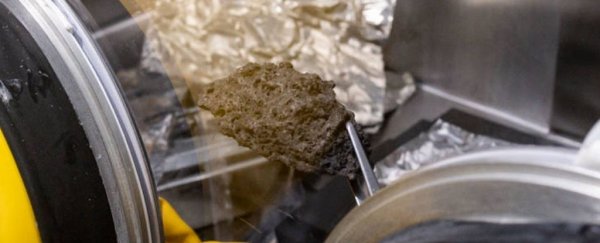When the Apollo 15 and 17 missions returned to Earth with pieces of the Moon in 1971 and 1972, some of the samples were deliberately set aside for the future.
Flash forward half a century and these samples are finally being studied.
In 2019, shortly after an upcoming Artemis mission to the Moon was announced, nine teams of researchers were selected to analyze the untouched rocks and soil brought back by the Apollo missions.
Some of the vacuum-sealed samples have never been opened on Earth before. Others have been carefully stored in a freezer since their arrival fifty years ago.
Transporting the precious cargo from Texas to NASA laboratories around the country has taken years of prep.
A special facility had to be built in Maryland at the Goddard Space Flight Center to house the lunar samples, and it took four years to set up.
Only now can researchers finally begin to analyze the long-kept treasures from the Apollo missions in prep for the Artemis missions.
"When you think of how these samples have come from another world, how far they have travelled and the Solar System history they have preserved inside of them, it always blows my mind," says planetary scientist Natalie Curran, who is studying the lunar samples at Goddard.
Some of the lunar pieces that Curran is analyzing were frozen upon arrival to Earth in 1972, and they need to be kept under precise conditions.
To handle the precious samples, researchers must enter a walk-in freezer kept at minus 20 degrees Celsius (4 degrees Fahrenheit) and stick their arms into a nitrogen-purged glove box. Only when their hands are covered in thick rubber gloves, can they touch the lunar rocks.
"Everything we do involves a lot of logistics and a lot of infrastructure, but adding the cold makes it a lot harder," says astromaterial researcher Ryan Zeigler, who helped curate the lab's handling methods.
"It's an important learning lesson for Artemis, as being able to process samples in the cold will be even more important for the Artemis mission than it is for Apollo. This work gives us some lessons learned and a good feed forward for Artemis."
 Frozen Apollo 17 sample being handled inside a nitrogen-purged glove box. (NASA/Robert Markowitz)
Frozen Apollo 17 sample being handled inside a nitrogen-purged glove box. (NASA/Robert Markowitz)
Curran is the principal investigator for Goddard's Mid Atlantic Noble Gas Research Lab, which is considering the lunar samples as time capsules.
Using noble gasses, the team is seeking to measure how long pieces from the surface of the Moon have been exposed to cosmic rays. That knowledge could help reveal how conditions on the Moon have changed over time.
"Cosmic rays can be damaging to organic material that may be in a sample, so understanding the duration helps to determine the effects that exposure has had on the organic," explains Curran.
Another team of researchers at Goddard's Astrobiology Analytical Laboratory is studying whether the lunar samples contain volatile organic compounds and at what concentrations.
Early studies in the 1970s found some lunar rocks contained amino acids, which are important building blocks of life on Earth. But since those days, technology and our understanding of astrobiology has improved a lot.
"We think some of the amino acids in the lunar soils may have formed from precursor molecules, which are smaller, more volatile compounds such as formaldehyde or hydrogen cyanide," explains Jamie Elsila, a researcher with the Astrobiology Analytical Laboratory.
"Our research goal is to identify and quantify these small organic volatile compounds, as well as any amino acids, and to use the data to understand the prebiotic organic chemistry of the Moon."
Researchers at NASA will also be comparing differences between frozen lunar samples and unfrozen samples, to see which preservation method proved better in the long run.
The findings will ultimately inform future handling of lunar samples, which will be brought back via the Artemis missions.
Some of the samples will no doubt be put aside for the future, when improved technology could help us see something we hadn't noticed before.
"It's very cool to think about all the work that went into collecting the samples on the Moon and then all the forethought and care that went into preserving them for us to be able to analyze at this time," says Elsila.
More information about the Apollo Next Generation Sample Analysis Program can be found here.
